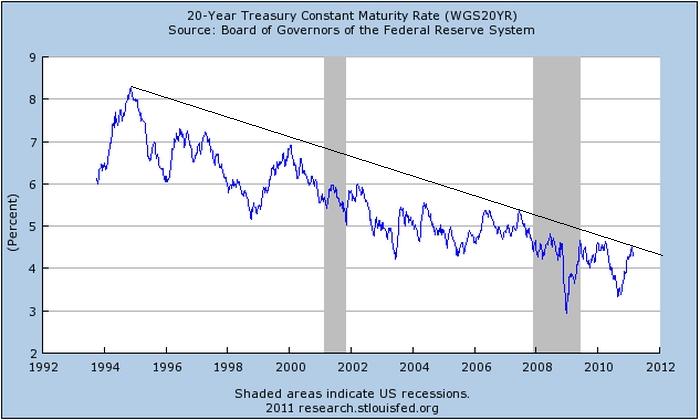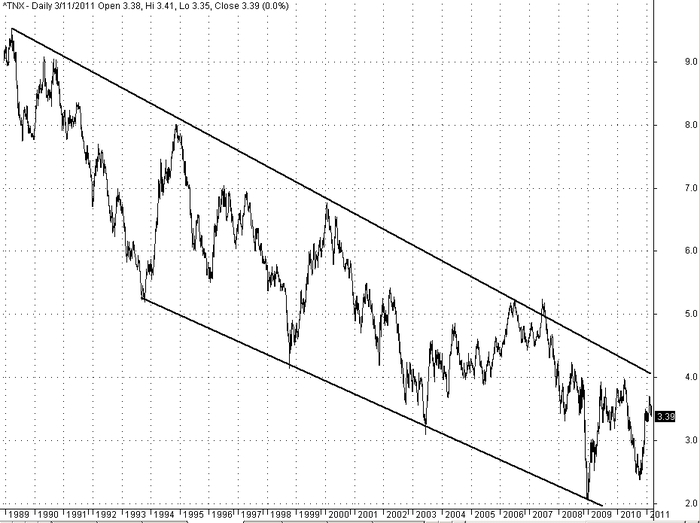Bill Gross, the founder of PIMCO, sold his Treasury bond holdings late last month as reported by Bloomberg. The manager of the world’s largest bond fund said that he thinks yields are low and he may buy Treasuries again when yields rise. In this post I will concentrate on what technical analysis tell us about the decision of Mr. Gross.
Several blogs I came across concentrated on a fundamental analysis of the reasons behind the sale. In my opinion the beauty of technical analysis is that it projects a multitude of economic parameters onto a 2-dimensional chart. Let us look at the first chart, the 20-yr Treasury constant maturity rate:
It may be seen from the chart that the 20-year Treasury constant maturity rate is close to testing resistance at the long-term trend line from 1994. The next resistance level is at around 5%. If the trendline is broken, it is possible that a sell-off of bonds will follow.
Below is a chart of the CBOE Index of interest rate of 10-yr Note:
It is also clear from this chart that the 10-year rate moved in a down channel since 1993 and is now close to the upper trendline that defines it. If the rate breaks resistance at 4% it will move towards 5%, the next resistance level. It is evident from the technical analysis view point that rates are both low and also close to resistance levels.
Next is a weekly chart of TLT, an ETF that tracks the Barclays Capital U.S. 20+ Year Treasury Bond index:
Recall that bond prices move opposite to bond yields, i.e. as yields rise, prices fall and vice versa. It may be seen from the weekly chart that prices are about to test the long-term trendline from 2003 at around $89. If this support is broken, the next major support level is near $85.
Therefore, technically speaking, based on the three charts presented, bond yields and prices are close to testing important, long-term, resistance and support levels, respectively. Some traders may be tempted to ask the following question: why didn’t Mr. Gross wait for a confirmation of a break of an important, long-term, support and resistance level before unloading his holdings but rushed to do it ahead of such technical signal?
The answer lies, in my opinion, in the large holdings of Mr. Gross. He could not wait for confirmation because of liquidity issues. If yields were to start rising due to a penetration of important long-term trendlines and support levels, there would be a lot of supply hitting the market and that would be the wrong timing for unloading a big position. The potential loss would be too high. Remember that the primary objective of a conservative bond fund manager is that of capital preservation. In this particular situation, the risks of liquidating and then seeing yields falling again is lower than that of not liquidating and then seeing yields rising. In other words, a decision to preserve capital was made in the face of an increased risk of rising rates.
Just to get an idea of the magnitude of potential losses, I used a calculator that was part of a bond portfolio optimization and index tracking program I developed when I was working in fixed income analytics and portfolio management in Wall Street back in the early 1990s. The program was written in Fortran 77 for MSDOS. I developed everything from scratch, including all functions for the calculation of yield, duration, convexity, optimal allocation, etc. It still works nicely though given the limitations of that language.
Let us consider $1,000 of face value of a 30-year Treasury bond with maturity 02/14/2041 and a coupon of 4.75%. The yield as of last Friday was 4.55%. The bond calculator below shows the sensitivity of the bond price to interest rate changes:
If the yield rises short-term from the current value of 4.55% to 4.90%, the price of the bond will drop from 103.2492 to 97.65419, a change of 5.42%. For $250 billion this amounts to about $13.55 billion in losses after liquidating the portfolio at the higher yield. We are talking about a lot of money here and possibly turning fund performance from positive to negative for the year, depending of course of the average duration and convexity of the actual portfolio. My rough guess is about $8 – $10 billion in losses while waiting for a confirmation.
The point I am trying to make is that market participants with the size of Mr. Gross cannot wait for supply to hit the market first and then liquidate. They must make the first move to preserve capital. They can then wait for yields to rise to buy cheaper. If yields do not rise but fall instead they will be sitting on cash instead of a huge loss. What do you prefer? I prefer the cash than a loss.
Disclaimer: The author is not a financial advisor and does not recommend the purchase of any security or advise on the suitability of any trade or investment in any timeframe. ETF, stock, futures, forex and options trading and investing involves substantial financial risks and can result in total loss of capital. If investment or other professional advice is required, a licensed professional should be consulted.










